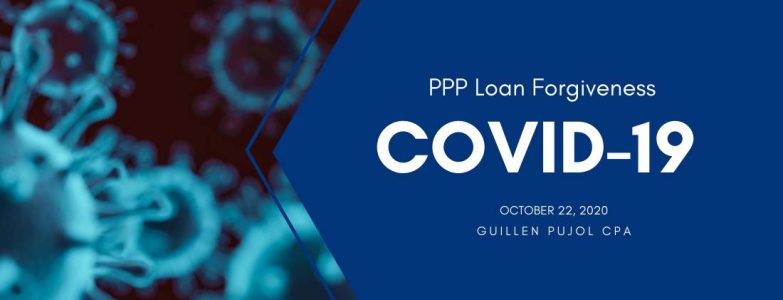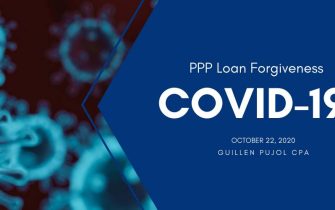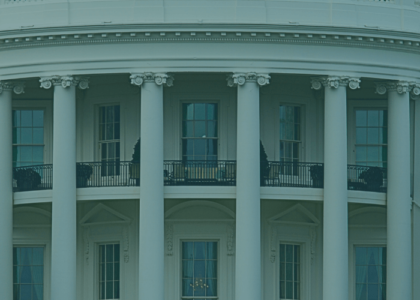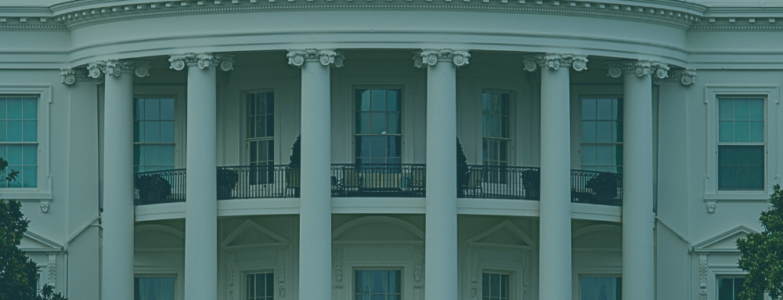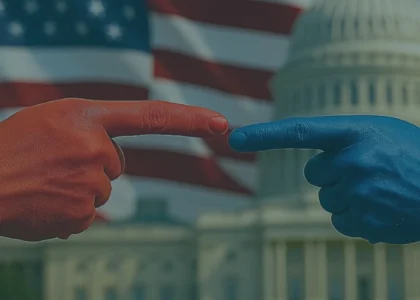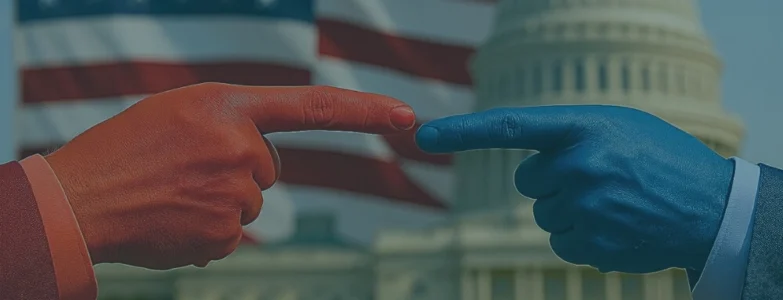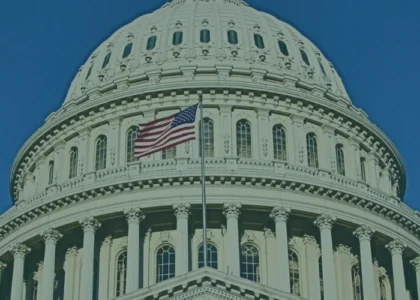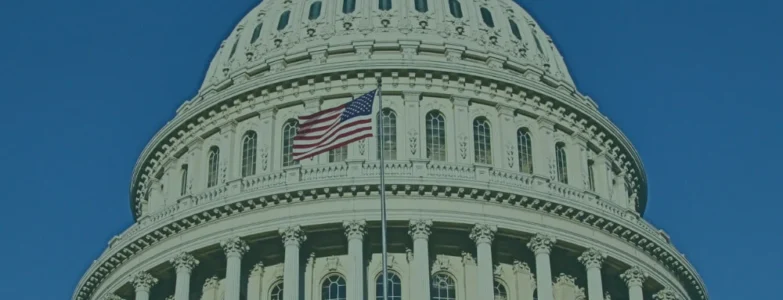ABOUT PAYCHECK PROTECTION PROGRAM
Concerns of a Paycheck Protection Program (PPP) surprise deadline for the end of October came to the attention of the U.S. Small Business Administration (SBA) because the program’s loan forgiveness application forms (3508, 3508EZ, and 3508S) display an expiration date of “10/31/2020” in the upper-right corner. This fear from thousands of applicants prompted the SBA to release guidance to finally address borrower and lender questions concerning the forgiveness of PPP loans, as provided for under section 1106 of the Coronavirus Aid, Relief, and Economic Security Act (CARES Act), as amended by the PPP Flexibility Act.
The PPP loan forgiveness applications are not due on Oct. 31.
Frequently Asked Questions (FAQs) on PPP Loan Forgiveness:
1. Which loan forgiveness application should sole proprietors, independent contractors, or self-employed individuals with no employees complete?
Sole proprietors, independent contractors, and self-employed individuals who had no employees at the time of the PPP loan application and did not include any employee salaries in the computation of average monthly payroll in the Borrower Application Form automatically qualify to use the Loan Forgiveness Application Form 3508EZ, or lender equivalent, and should complete that application.
2. Can PPP lenders use scanned copies of documents, E-signatures, or Econsents for loan forgiveness applications and loan forgiveness documentation?
Yes.
All PPP lenders may accept scanned copies of signed loan forgiveness applications and documents containing the information and certifications required by SBA Form 3508, 3508EZ, or lender equivalent. Lenders may accept any form of E-consent or E-signature that complies with the requirements of the Electronic Signatures in Global and National Commerce Act (PL 106-229). If electronic signatures are not feasible, then when obtaining a wet ink signature without in-person contact, lenders should take appropriate steps to ensure the proper party has executed the document. This guidance does not supersede signature requirements imposed by other applicable law, including the lender’s primary federal regulator.
3. If a borrower submits a timely loan forgiveness application, does the borrower have to make any payments on its loan before SBA remitting the forgiveness amount, if any?
As long as a borrower submits its loan forgiveness application within ten months of completing the Covered Period (as defined below), the borrower is not (as of Oct. 13, 2020) required to make any payments until the forgiveness amount is remitted to the lender by SBA. If the loan is fully forgiven, the borrower is not responsible for any payments. If only a portion of the loan is forgiven, or if the forgiveness application is denied, any remaining balance due must be repaid by the borrower on or before the loan’s maturity date. Interest accrues during the time between the disbursement of the loan and SBA remittance of the forgiveness amount. The borrower is responsible for paying the accrued interest on any amount of the loan that is not forgiven. The lender is responsible for notifying the borrower of remittance by SBA of the loan forgiveness amount (or that SBA determined that no amount of the loan is eligible for forgiveness) and the date on which the borrower’s first payment is due, if applicable.
4. The PPP loan forgiveness application forms (3508, 3508EZ, and 3508S) display an expiration date of 10/31/2020 in the upper-right corner. Is Oct. 31, 2020, the deadline for borrowers to apply for forgiveness?
No.
Borrowers may submit a loan forgiveness application any time before the maturity date of the loan, which is either two or five years from loan origination. However, if a borrower does not apply for loan forgiveness within ten months after the last day of the borrower’s loan forgiveness covered period, loan payments are no longer deferred, and the borrower must begin making payments on the loan. For example, a borrower whose covered period ends on Oct. 30, 2020, has until Aug. 30, 2021, to apply for forgiveness before loan repayment begins. The expiration date in the upper-right corner of the posted PPP loan forgiveness application forms is displayed for purposes of SBA’s compliance with the Paperwork Reduction Act and reflects the temporary expiration date for the approved use of the forms. This date will be extended, and when approved, the same forms with the new expiration date will be posted.
Frequently Asked Questions (FAQs) on Loan Forgiveness Payroll Costs:
The PPP loan forgiveness application forms (3508, 3508EZ, and 3508S) display an expiration date of 10/31/2020 in the upper-right corner. Is Oct. 31, 2020, the deadline for borrowers to apply for forgiveness?
1. Are payroll costs that were incurred during the Covered Period or the Alternative Payroll Covered Period but paid after the Covered Period or the Alternative Payroll Covered Period eligible for loan forgiveness?
Yes, if the payroll costs are paid on or before the next regular payroll date after the Covered Period or Alternative Payroll Covered Period.
Example: A borrower received its loan before Jun. 5, 2020, and elects to use a 24-week Covered Period. The borrower’s Covered Period runs from Monday, Apr. 20, through Sunday, Oct. 4. The borrower has a biweekly payroll cycle, with a pay period ending on Sunday, Oct. 4. However, the borrower will not make the corresponding payroll payment until the next regular payroll date of Friday, Oct. 9. Under these circumstances, the borrower incurred payroll costs during the Covered Period and may seek loan forgiveness for the payroll costs paid on Oct. 9 because the cost was incurred during the Covered Period, and the payment was made on the first regular payroll date after the Covered Period.
2. Are payroll costs that were incurred before the Covered Period but paid during the Covered Period eligible for loan forgiveness?
Yes.
Example: A borrower received its loan before Jun. 5, 2020, and elects to use a 24-week Covered Period. The borrower’s Covered Period runs from Monday, Apr. 20 through Sunday, Oct. 4. The borrower has a biweekly payroll cycle, with a payroll cycle ending on Saturday, Apr. 18. The borrower will not make the corresponding payroll payment until Friday, Apr. 24. While these payroll costs were not incurred during the Covered Period, they were paid during the Covered Period and are therefore eligible for loan forgiveness.
3. Are borrowers required to calculate payroll costs for partial pay periods?
If the borrower uses a biweekly or more frequent (e.g., weekly) payroll cycle, the borrower may elect to calculate eligible payroll costs using the eight-week (for borrowers that received their loans before Jun. 5, 2020, and elect this Covered Period length) or 24-week period that begins on the first day of the first payroll cycle following the PPP Loan Disbursement Date (referred to as the Alternative Payroll Covered Period). However, if a borrower pays twice a month or less frequently, it will need to calculate payroll costs for partial pay periods. The Covered Period or Alternative Covered Period for any borrower will end no later than Dec. 31, 2020. Example: A borrower uses a biweekly payroll cycle. The borrower’s 24-week Covered Period begins on Monday, Jun. 1, and ends on Sunday, Nov. 15. The first day of the borrower’s first payroll cycle that starts in the Covered Period is Jun. 7. The borrower may elect an Alternative Payroll Covered Period that begins on Jun. 7 and ends on Nov. 21 (167 days later). Payroll costs incurred (i.e., the pay was earned on that following its PPP loan disbursement is Sunday, Apr. 26, the first day of the Alternative Payroll Covered Period is Apr. 26 and the last day of the Alternative Payroll Covered Period is Saturday, Oct. 10. In no event may the Alternative Payroll Covered Period extend beyond Dec. 31, 2020. During this Alternative Payroll-Covered Period, loan forgiveness is eligible if the last payment is made on or before the first regular payroll date after Nov. 21.
4. For purposes of calculating cash compensation, should borrowers use the gross amount before deductions for taxes, employee benefits payments, and similar payments, or the net amount paid to employees?
The gross amount should be used when calculating cash compensation.
5. Are only salaries or wages covered by loan forgiveness, or can a borrower pay lost tips, lost commissions, bonuses, or other forms of incentive pay and have such costs qualify for loan forgiveness?
Payroll costs include all forms of cash compensation paid to employees, including tips, commissions, bonuses, and hazard pay. Note that forgivable cash compensation per employee is limited to $100,000 on an annualized basis.
6. What expenses for group health care benefits will be considered payroll costs that are eligible for loan forgiveness?
Employer expenses for employee group healthcare benefits paid or incurred by the borrower during the Covered Period or the Alternative Payroll Covered Period are payroll costs eligible for loan forgiveness. However, payroll costs do not include expenses for group health care benefits paid by employees (or beneficiaries of the plan) either pre-tax or after-tax, such as the employee share of their health care premium. Forgiveness is not provided for expenses for group health benefits accelerated from periods outside the Covered Period or Alternative Payroll Covered Period. If a borrower has an insured group health plan, insurance premiums paid or incurred during the Covered Period or Alternative Payroll Covered Period qualify as “payroll costs,” as long as the premiums are paid during the applicable period or by the next premium due date after the end of the applicable period. As noted, only the portion of the premiums paid by the borrower for coverage during the applicable Covered Period or Alternative Payroll Covered Period is included, not any amount paid by employees or beneficiaries or any portion paid for coverage for periods outside the applicable period.
7. What contributions for retirement benefits will be considered payroll costs that are eligible for loan forgiveness?
Generally, employer contributions for employee retirement benefits that are paid or incurred by the borrower during the Covered Period or Alternative Payroll Covered Period qualify as “payroll costs” eligible for loan forgiveness. The employer contributions for retirement benefits included in the loan forgiveness amount as payroll costs cannot include any retirement contributions deducted from employees’ pay or otherwise paid by employees. Forgiveness is not provided for employer contributions for retirement benefits accelerated from periods outside the Covered Period or Alternative Covered Period. Loan Forgiveness Payroll Costs FAQ 8 outlines the treatment of retirement benefits for owners, which are different from this general approach.
8. How is the amount of owner compensation that is eligible for loan forgiveness determined?
The amount of compensation of owners who work at their business that is eligible for forgiveness depends on the business type and whether the borrower is using an eight-week or 24-week Covered Period. In addition to the specific caps described below, the amount of loan forgiveness requested for owner-employees and self-employed individuals’ payroll compensation is capped at $20,833 per individual in total across all businesses in which he or she has an ownership stake. For borrowers that received a PPP loan before Jun. 5, 2020, and elect to use an eight-week Covered Period, this cap is $15,385. If their total compensation across businesses that receive a PPP loan exceeds the cap, owners can choose how to allocate the capped amount across different businesses. The examples below are for a borrower using a 24-week Covered Period.
C Corporations: The employee cash compensation of a C-corporation owner-employee, defined as an owner who is also an employee (including where the owner is the only employee), is eligible for loan forgiveness up to the amount of 2.5/12 of his or her 2019 employee cash compensation, with cash compensation defined as it is for all other employees. Borrowers are also eligible for loan forgiveness for payments for employer state and local taxes paid by the borrowers and assessed on their compensation, for the amount paid by the borrower for employer contributions for their employee health insurance, and for employer retirement contributions to their employee retirement plans capped at the amount of 2.5/12 of the 2019 employer retirement contribution. Payments other than for cash compensation should be included in lines 6-8 of PPP Schedule A of the loan forgiveness application (SBA Form 3508 or lender equivalent) for borrowers using that form and do not count toward the $20,833 cap per individual.
S Corporations: The employee cash compensation of an S-corporation owner-employee, defined as an owner who is also an employee, is eligible for loan forgiveness up to 2.5/12 of their 2019 employee cash compensation, with cash compensation defined as it is for all other employees. Borrowers are also eligible for loan forgiveness for payments for employer state and local taxes paid by the borrowers and assessed on their compensation, and for employer retirement contributions to their employee retirement plans capped at the amount of 2.5/12 of their 2019 employer retirement contribution. Employer contributions for health insurance are not eligible for additional forgiveness for S-corporation employees with at least a 2% stake in the business, including for employees who are family members of an at least 2% owner under the family attribution rules of 26 USC 318, because those contributions are included in cash compensation. The eligible non-cash compensation payments should be included on lines 7 and 8 of PPP Schedule A of the Loan Forgiveness Application (SBA Form 3508), for borrowers using that form, and do not count toward the $20,833 cap per individual.
Self-employed Schedule C (or Schedule F) filers: The compensation of self-employed Schedule C (or Schedule F) individuals, including sole proprietors, self-employed individuals, and independent contractors, that is eligible for loan forgiveness is limited to 2.5/12 of 2019 net profit as reported on IRS Form 1040 Schedule C line 31 (or 2.5/12 of 2019 net farm profit, as reported on IRS Form 1040 Schedule F line 34) (or for new businesses, the estimated 2020 Schedule C (or Schedule F) referenced in question 10 of “Paycheck Protection Program: How to Calculate Maximum Loan Amounts – By Business Type” 4 ). Separate payments for health insurance, retirement, or state or local taxes are not eligible for additional loan forgiveness; health insurance and retirement expenses are paid out of their net self-employment income. If the borrower did not submit its 2019 IRS Form 1040 Schedule C (or F) to the lender when the borrower initially applied for the loan, it must be included with the borrower’s forgiveness application.
General Partners: The compensation of general partners that is eligible for loan forgiveness is limited to 2.5/12 of their 2019 net earnings from self-employment that is subject to self-employment tax, which is computed from 2019 IRS Form 1065 Schedule K-1 box 14a (reduced by box 12 section 179 expense deduction, unreimbursed partnership expenses deducted on their IRS Form 1040 Schedule SE, and depletion claimed on oil and gas properties) multiplied by 0.9235.5 Compensation is only eligible for loan forgiveness if the payments to partners are made during the Covered Period or Alternative Payroll Covered Period. Separate payments for health insurance, retirement, or state or local taxes are not eligible for additional loan forgiveness. If the partnership did not submit its 2019 IRS Form 1065 K-1s when initially applying for the loan, it must be included with the partnership’s forgiveness application.
LLC owners: LLC owners must follow the instructions that apply to how their business was organized for tax filing purposes for the tax year 2019, or if a new business, the expected tax filing situation for 2020.
Frequently Asked Questions (FAQs) on Loan Forgiveness Nonpayroll Costs:
1. Are nonpayroll costs incurred prior to the Covered Period, but paid during the Covered Period, eligible for loan forgiveness?
Yes, eligible business mortgage interest costs, eligible business rent or lease costs, and eligible business utility costs incurred prior to the Covered Period and paid during the Covered Period are eligible for loan forgiveness. Example: A borrower’s 24-week Covered Period runs from Apr. 20, through Oct. 4. On May 4, the borrower receives its electricity bill for April. The borrower pays its April electricity bill on May 8. Although a portion of the electricity costs was incurred before the Covered Period, these electricity costs are eligible for loan forgiveness because they were paid during the Covered Period.
2. Are nonpayroll costs incurred during the Covered Period, but paid after the Covered Period, eligible for loan forgiveness?
Nonpayroll costs are eligible for loan forgiveness if they were incurred during the Covered Period and paid on or before the next regular billing date, even if the billing date is after the Covered Period. Example: A borrower’s 24-week Covered Period runs from Apr. 20 through Oct. 4. On Oct. 6, the borrower receives its electricity bill for September. The borrower pays its September electricity bill on Oct. 16. These electricity costs are eligible for loan forgiveness because they were incurred during the Covered Period and paid on or before the next regular billing date (Nov. 6).
3. If a borrower elects to use the Alternative Payroll Covered Period for payroll costs, does the Alternative Payroll Covered Period apply to nonpayroll costs?
No. The Alternative Payroll Covered Period applies only to payroll costs, not to nonpayroll costs. The Covered Period always starts on the date the lender makes a disbursement of the PPP loan. Nonpayroll costs must be paid or incurred during the Covered Period to be eligible for loan forgiveness. For payroll costs only, the borrower may elect to use the Alternative Payroll Covered Period to align with its biweekly or more frequent payroll schedule.
4. Is interest on unsecured credit eligible for loan forgiveness?
No. Payments of interest on business mortgages on real or personal property (such as an auto loan) are eligible for loan forgiveness. Interest on unsecured credit is not eligible for loan forgiveness because the loan is not secured by real or personal property. Although interest on unsecured credit incurred before Feb. 15, 2020 is a permissible use of PPP loan proceeds, this expense is not eligible for forgiveness.
5. Are payments made on recently renewed leases or interest payments on refinanced mortgage loans eligible for loan forgiveness if the original lease or mortgage existed prior to Feb. 15, 2020?
Yes. If a lease that existed prior to Feb. 15, 2020, expires on or after Feb. 15, 2020, and is renewed, the lease payments made pursuant to the renewed lease during the Covered Period are eligible for loan forgiveness. Similarly, if a mortgage loan on real or personal property that existed prior to Feb. 15, 2020, is refinanced on or after Feb. 15, 2020, the interest payments on the refinanced mortgage loan during the Covered Period are eligible for loan forgiveness. Example: A borrower entered into a five-year lease for its retail space in March 2015. The lease was renewed in March 2020. For purposes of determining forgiveness of the borrower’s PPP loan, the March 2020 renewed lease is deemed to be an extension of the original lease, which was in force before Feb. 15, 2020. As a result, the lease payments made under the renewed lease during the Covered Period are eligible for loan forgiveness.
6. Covered utility payments, which are eligible for forgiveness, include a “payment for a service for the distribution of . . . transportation” under the CARES Act. What expenses does this category include?
A service for the distribution of transportation refers to transportation utility fees assessed by state and local governments. The payment of these fees by the borrower is eligible for loan forgiveness.
7. Are electricity supply charges eligible for loan forgiveness if they are charged separately from electricity distribution charges?
Yes. The entire electricity bill payment is eligible for loan forgiveness (even if charges are invoiced separately), including supply charges, distribution charges, and other charges, such as gross receipts taxes.
Frequently Asked Questions (FAQs) on Loan Forgiveness Reductions:
1. Will a borrower be subject to a reduction to its forgiveness amount due to a reduction in FTE employees during the Covered Period if the borrower offered to rehire one or more laid-off employees, but the employees declined?
In calculating its loan forgiveness amount, a borrower may exclude any reduction in FTE employees if the borrower is able to document in good faith the following:
(1) an inability to rehire individuals who were employees of the borrower on Feb. 15, 2020, and (2) an inability to hire similarly qualified individuals for unfilled positions on or before Dec. 31, 2020. Borrowers are required to inform the applicable state unemployment insurance office of any employee’s rejected rehire offer within 30 days of the employee’s rejection of the offer. The documents that borrowers should maintain to show compliance with this exemption include the written offer to rehire an individual, a written record of the offer’s rejection, and a written record of efforts to hire a similarly qualified individual.
2. If a seasonal employer elects to use a 12-week period between May 1, 2019, and Sept. 15, 2019, to calculate its maximum PPP loan amount, what period in 2019 should be used as the reference period for calculating any reductions in the loan forgiveness amount?
A seasonal employer that elects to use a 12-week period between May 1, 2019 and Sept. 15, 2019, to calculate its maximum PPP loan amount must use the same 12-week period as the reference period for calculation of any reduction in the amount of loan forgiveness.
3. When calculating the FTE Reduction Exceptions in Table 1 of the PPP Schedule A Worksheet on the Loan Forgiveness Application (SBA Form 3508 or lender equivalent), do borrowers include employees who made more than $100,000 in 2019 (those listed in Table 2 of the PPP Schedule A Worksheet)?
Yes. The FTE Reduction Exceptions apply to all employees, not just those who would be listed in Table 1 of the Loan Forgiveness Application (SBA Form 3508 or lender equivalent). Borrowers should therefore include employees who made more than $100,000 in the FTE Reduction Exception line in Table 1 of the PPP Schedule A Worksheet.
4. How do borrowers calculate the reduction in their loan forgiveness amount arising from reductions in employee salary or hourly wage?
Certain pay reductions during the Covered Period or the Alternative Payroll Covered Period may reduce the amount of loan forgiveness a borrower will receive. If the salary or hourly wage of a covered employee7 is reduced by more than 25% during the Covered Period or the Alternative Payroll Covered Period, the portion in excess of 25% reduces the eligible forgiveness amount unless the borrower satisfies the Salary/Hourly Wage Reduction Safe Harbor (as described in the Loan Forgiveness Application (SBA Form 3508 or lender equivalent)). The examples below assume that each employee is a “covered employee.”
Example 1: A borrower received its PPP loan before Jun. 5, 2020, and elected to use an eight-week covered period. Its full-time salaried employee’s pay was reduced during the Covered Period from $52,000 per year to $36,400 per year on Apr. 23, 2020, and not restored by Dec. 31, 2020. The employee continued to work on a full-time basis with a full-time equivalency (FTE) of 1.0. The borrower should refer to the “Salary/Hourly Wage Reduction” section under the “Instructions for PPP Schedule A Worksheet” in the PPP Loan Forgiveness Application Instructions. In Step 1, the borrower enters the figures in 1.a, 1.b, and 1.c, and because the annual salary was reduced by more than 25%, the borrower proceeds to Step 2. Under Step 2, because the salary reduction was not remedied by Dec. 31, 2020, the Salary/Hourly Wage Reduction Safe Harbor is not met, and the borrower is required to proceed to Step 3. Under Step 3.a., $39,000 (75% of $52,000) is the minimum salary that must be maintained to avoid a penalty. The salary was reduced to $36,400, and the excess reduction of $2,600 is entered in Step 3.b. Because this employee is salaried, in Step 3.e., the borrower would multiply the excess reduction of $2,600 by 8 (if it had instead selected a 24-week Covered Period, it would multiply by 24) and divide by 52 to arrive at a loan forgiveness reduction amount of $400. The borrower would enter the PPP Schedule A Worksheet, Table 1, $400 as the salary/hourly wage reduction in the column above box 3 for that employee.
Example 2: A borrower received its PPP loan before Jun. 5, 2020, and elected to use a 24-week Covered Period. An hourly employee’s hourly wage was reduced from $20 per hour to $15 per hour during the Covered Period. The employee worked 10 hours per week between Jan. 1, 2020, and Mar. 31, 2020. The borrower should refer to the “Salary/Hourly Wage Reduction” section under the “Instructions for PPP Schedule A Worksheet” in the PPP Loan Forgiveness Application Instructions. Because the employee’s hourly wage was reduced by exactly 25% (from $20 per hour to $15 per hour), the wage reduction does not reduce the eligible forgiveness amount. The amount on line 1.c would be 0.75 or more, so the borrower would enter $0 in the Salary/Hourly Wage Reduction column for that employee on the PPP Schedule A Worksheet, Table 1. If the same employee’s hourly wage had been reduced to $14 per hour, the reduction would be more than 25%, and the borrower would proceed to Step 2. If that reduction were not remedied as of Dec. 31, 2020, the borrower would proceed to Step 3. This reduction in hourly wage in excess of 25% is $1 per hour. In Step 3, the borrower would multiply $1 per hour by 10 hours per week to determine the weekly salary reduction. The borrower would then multiply the weekly salary reduction by 24 (because the borrower is using a 24-week Covered Period). The borrower would enter $240 in the Salary/Hourly Wage Reduction column for that employee on the PPP Schedule A Worksheet, Table 1. If the borrower applies for forgiveness before the end of the 24-week Covered Period, it must account for the salary reduction (the excess reduction over 25%, or $240) for the full 24-week Covered Period.
Example 3: An employee earned a wage of $20 per hour between Jan. 1, 2020, and Mar. 31, 2020, and worked 40 hours per week. During the Covered Period, the employee’s wage was not changed, but his or her hours were reduced to 25 hours per week. In this case, the salary/hourly wage reduction for that employee is zero, because the hourly wage was unchanged. As a result, the borrower would enter $0 in the Salary/Hourly Wage Reduction column for that employee on the PPP Schedule A Worksheet, Table 1. The employee’s reduction in hours would be taken into account in the borrower’s calculation of its FTE during the Covered Period, which is calculated separately and may reduce the borrower’s loan forgiveness amount.
5. For purposes of calculating the loan forgiveness reduction required for salary/hourly wage reductions in excess of 25% for certain employees, are all forms of compensation included or only salaries and wages?
For purposes of calculating reductions in the loan forgiveness amount, the borrower should only take into account decreases in salaries or wages.
Frequently Asked Questions (FAQs) on Economic Injury Disaster Loan (EIDL):
1. SBA will deduct the amount of any Economic Injury Disaster Loan (EIDL) advance received by a PPP borrower from the forgiveness amount remitted to the lender. How will a lender know the amount of the EIDL advance that will be automatically deducted by SBA?
If a borrower received an EIDL advance, SBA is required to reduce the borrower’s loan forgiveness amount by the amount of the EIDL advance. SBA will deduct the amount of the EIDL advance from the forgiveness amount remitted by SBA to the lender. The lender will be able to confirm the amount of the EIDL advance that will be automatically deducted by SBA from the forgiveness payment by reviewing the borrower’s EIDL advance information in the PPP Forgiveness Platform.
2. How should a lender handle any remaining balance due on a PPP loan after SBA remits the forgiveness amount to the lender?
If a PPP loan is not forgiven in full (including if there has been a reduction in the forgiveness amount for an EIDL advance), any remaining balance due on the PPP loan must be repaid by the borrower. The lender is responsible for notifying the borrower of the loan forgiveness amount remitted by SBA and the date on which the borrower’s first loan payment is due. The lender must continue to service the loan. The borrower must repay the remaining loan balance by the maturity date of the PPP loan (either two or five years). If a borrower is determined to have been ineligible for a PPP loan for any reason, SBA may seek repayment of the outstanding PPP loan balance or pursue other available remedies.
3. What should a lender do if a borrower received an EIDL advance in excess of the amount of its PPP loan?
A borrower that received an EIDL advance in excess of the amount of its PPP loan will not receive any forgiveness on the PPP loan, because the amount of an EIDL advance is deducted from the PPP loan forgiveness amount. The lender is responsible for notifying the borrower of the date on which the borrower’s first loan payment is due. The lender must continue to service the loan. The borrower must repay the remaining loan balance by the maturity date of the PPP loan (either two or five years). If a borrower is determined to have been ineligible for a PPP loan for any reason, SBA may seek repayment of the outstanding PPP loan balance or pursue other available remedies.
Source: https://www.sba.gov via the Journal of Accountancy.
Please note that the SBS released this guidance on Oct. 2020, and it might be subject to change.
At Guillen Pujol CPAs, we are ready to assist you with your forgiveness application process and preparing all necessary additional documentation.
Please feel free to contact us if you need any further information.



